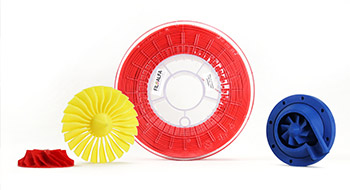ALFAPLUS and ALFAPRO annealing process
Annealing improves the mechanical and physical characteristics of FILOALFA® ALFAPLUS and ALFAPRO.
To determine the optimal temperatures and times for annealing of the two materials, various tests were performed on 4 mm thick specimens.
For pieces with lower thicknesses, we are not able to recommend lower annealing times, while for prints with greater thicknesses, it may be necessary to increase the annealing time to allow
However, we do not consider it necessary to go beyond 1 hour for
Procedure for a correct annealing process for the FILOALFA® ALFAPLUS and alfapro products
The optimum annealing temperature was
Descending below this temperature can compromise the crystallization reaction.
To avoid an excessive softening of the material it is advisable to insert the product in an oven already at temperature, thus avoiding any thermal ramps.
The kinetics related to the annealing and the achievement of a complete crystallization of the two materials are very different from each other:
- For
ALFAPLUS a time of at least 30 minutes is required at 100°C. - On the other hand, the annealing kinetics of ALFAPRO is much faster and takes only 5 minutes at 100°C.
These times are much lower than the standard times recommended for the annealing of any similar materials, this mainly because
We also report that these values were obtained through standard thermal tests on specimens subjected to bending stresses.
Deformation and color.
Due to the self-tensions generated during the printing process, especially in the absence of a hot chamber, the pieces exposed to the heat of the oven could be deformed. To limit it as much as possible, the piece can be placed in a suitable container and filled with sand.
The pressure of the sand will prevent the piece from deforming and will support any thin walls or protrusions in the absence of printed supports. The insulating power of sand, of course, will require longer periods of time in the oven.
For the same
If the prints are made in
Calculate isotropic shrinkage.
During the annealing
This withdrawal tends to be isotropic, ie equal for all dimensions. Since the printing conditions influence the thermal characteristics of the piece, it is strongly advised to test it on a cubic specimen measuring its dimensions before and after the process: making a ratio between the dimensions, a parameter will be obtained for each of them it must be used as a dimensional multiplier in the slicer before printing.
For example, if the three dimensions of a cube were 50x50x50 mm and at the end of the process we obtained 49.2.49.0.47.3 mm, the coefficients would be: 1.016, 1.02 and 1.057.
In summary, therefore, these are the few simple steps:
- Resize with the slicer and print the object taking into account
an isotropic shrinkage of 1.5-2.0%. - Preheat the oven to 100° C.
- If the object is delicate and/or deformations are to be minimized, place the object in a container filled with sand.
- Insert object and container in the oven.
- Wait for the annealing process: 30 minutes for
ALFAPLUS and 5 minutes for ALFAPRO. (If inside the sand increase these times respectively to at least 1 hour and 30 minutes). - Allow the object to cool.
- Remove any support.
For any clarification, you can contact our technical support through the contact page.











